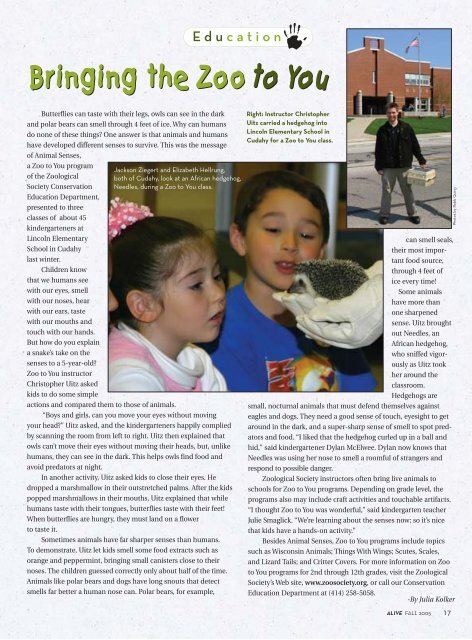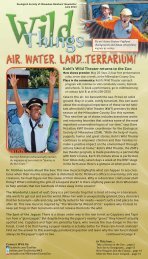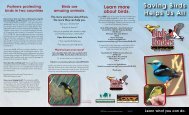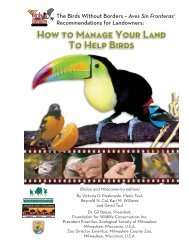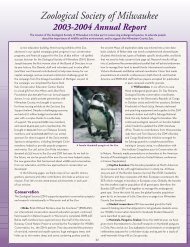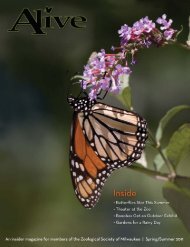AliveFall 2005 - Zoological Society of Milwaukee
AliveFall 2005 - Zoological Society of Milwaukee
AliveFall 2005 - Zoological Society of Milwaukee
You also want an ePaper? Increase the reach of your titles
YUMPU automatically turns print PDFs into web optimized ePapers that Google loves.
Education<br />
Bringing the Zoo to You<br />
Butterflies can taste with their legs, owls can see in the dark<br />
and polar bears can smell through 4 feet <strong>of</strong> ice. Why can humans<br />
do none <strong>of</strong> these things? One answer is that animals and humans<br />
have developed different senses to survive. This was the message<br />
<strong>of</strong> Animal Senses,<br />
a Zoo to You program<br />
Jackson Ziegert and Elizabeth Hellrung,<br />
<strong>of</strong> the <strong>Zoological</strong><br />
both <strong>of</strong> Cudahy, look at an African hedgehog,<br />
<strong>Society</strong> Conservation Needles, during a Zoo to You class.<br />
Education Department,<br />
presented to three<br />
classes <strong>of</strong> about 45<br />
kindergarteners at<br />
Lincoln Elementary<br />
School in Cudahy<br />
last winter.<br />
Children know<br />
that we humans see<br />
with our eyes, smell<br />
with our noses, hear<br />
with our ears, taste<br />
with our mouths and<br />
touch with our hands.<br />
But how do you explain<br />
a snake’s take on the<br />
senses to a 5-year-old?<br />
Zoo to You instructor<br />
Christopher Uitz asked<br />
kids to do some simple<br />
actions and compared them to those <strong>of</strong> animals.<br />
“Boys and girls, can you move your eyes without moving<br />
your head?” Uitz asked, and the kindergarteners happily complied<br />
by scanning the room from left to right. Uitz then explained that<br />
owls can’t move their eyes without moving their heads, but, unlike<br />
humans, they can see in the dark. This helps owls find food and<br />
avoid predators at night.<br />
In another activity, Uitz asked kids to close their eyes. He<br />
dropped a marshmallow in their outstretched palms. After the kids<br />
popped marshmallows in their mouths, Uitz explained that while<br />
humans taste with their tongues, butterflies taste with their feet!<br />
When butterflies are hungry, they must land on a flower<br />
to taste it.<br />
Sometimes animals have far sharper senses than humans.<br />
To demonstrate, Uitz let kids smell some food extracts such as<br />
orange and peppermint, bringing small canisters close to their<br />
noses. The children guessed correctly only about half <strong>of</strong> the time.<br />
Animals like polar bears and dogs have long snouts that detect<br />
smells far better a human nose can. Polar bears, for example,<br />
Right: Instructor Christopher<br />
Uitz carried a hedgehog into<br />
Lincoln Elementary School in<br />
Cudahy for a Zoo to You class.<br />
can smell seals,<br />
their most important<br />
food source,<br />
through 4 feet <strong>of</strong><br />
ice every time!<br />
Some animals<br />
have more than<br />
one sharpened<br />
sense. Uitz brought<br />
out Needles, an<br />
African hedgehog,<br />
who sniffed vigorously<br />
as Uitz took<br />
her around the<br />
classroom.<br />
Hedgehogs are<br />
small, nocturnal animals that must defend themselves against<br />
eagles and dogs. They need a good sense <strong>of</strong> touch, eyesight to get<br />
around in the dark, and a super-sharp sense <strong>of</strong> smell to spot predators<br />
and food. “I liked that the hedgehog curled up in a ball and<br />
hid,” said kindergartener Dylan McElwee. Dylan now knows that<br />
Needles was using her nose to smell a roomful <strong>of</strong> strangers and<br />
respond to possible danger.<br />
<strong>Zoological</strong> <strong>Society</strong> instructors <strong>of</strong>ten bring live animals to<br />
schools for Zoo to You programs. Depending on grade level, the<br />
programs also may include craft activities and touchable artifacts.<br />
“I thought Zoo to You was wonderful,” said kindergarten teacher<br />
Julie Smaglick. “We’re learning about the senses now; so it’s nice<br />
that kids have a hands-on activity.”<br />
Besides Animal Senses, Zoo to You programs include topics<br />
such as Wisconsin Animals; Things With Wings; Scutes, Scales,<br />
and Lizard Tails; and Critter Covers. For more information on Zoo<br />
to You programs for 2nd through 12th grades, visit the <strong>Zoological</strong><br />
<strong>Society</strong>’s Web site, www.zoosociety.org, or call our Conservation<br />
Education Department at (414) 258-5058.<br />
-By Julia Kolker<br />
ALIVE FALL <strong>2005</strong> 17<br />
Photos by Robb Quinn


